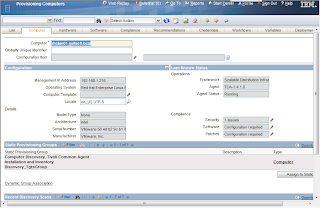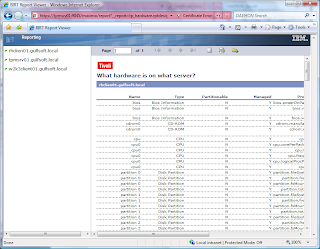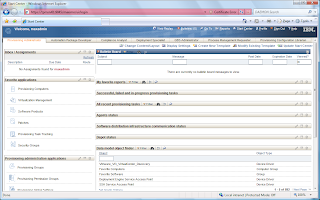Downloads
Get ready for another big download. To download the media for Windows, it was approximately 15GB. I also downloaded the Linux media, but really they do share a bunch between the various OS installs, so this was only another 5GB. The IBM document for downloading is located at http://www-01.ibm.com/support/docview.wss?uid=swg24020532
Installation
For now, I have only done the Windows based install as I was more interested in the actual product usage rather than fighting with an install at this time. Little did I know that the install would be a bit of a fight.
I decided to go with the default install for now just to get it up and running. So I brought up my trusty Windows 2003 SP2 VM image and started to prep it for the installation. Since the disk requirements were more than I allocated to my C drive, I created a new drive and allocated 50GB for an E drive. I then extracted the images to the E drive and started installing. After a few pages of entering information, I started to get failures. After checking around and asking IBM support, it turns out the default install is only supported on one volume (this is in the documentation, but not really clear as I was installing everything on one “volume”, the E drive). So I had to increase the C drive space (thanks to VMware Converter) and start again. After that the install went fine. It took about 5 hours to complete.
Start Up
Starting TPM is not much different than it was in the 5.x versions. There is a nice little icon to start and stop TPM. The only issue I had is that the TDS (Tivoli Directory Server) does not start automatically. This means that you cannot log in! You have to manually start the TDS service. I am sure that this has something to do with startup prereqs, but have not investigated right now.
New User Interface
Because I have used TSRM (Tivoli Service Request Manager), the interface was not that foreign to me, but still way different than the 5.x interface. I find that it is not as fluid as the old interface but is way more powerful and flexible. With a proper layout, I am sure that it can be way easier to navigate than 5.x.
One thing that does bug me is that Internet Explorer is the only supported browser. I have been using Firefox and everything seems to work fine except for the reports (could be just my setup)
The new interface has tabs which are called Start Center Templates. These start Centers can be setup to provide shortcuts into the application that are specific to the function of the user. So if you have someone that is an inventory specialist, you can create a layout that will provide quick access to everything they need to perform their job rather than displaying what they do not need like workflows and security. A user/group can also be assigned multiple Start Center templates. This is useful for using existing templates created for various job functions and providing them to a user whose role spreads multiple areas.
Discovery
There is something new called a Discovery Wizard. These wizards can perform multiple functions for discovery rather than the one step discovery (RXA discovery or inventory). For example, one wizard is called Computer Discovery, Common Agent Installation and Inventory Discovery. This discovery does exactly what it says. The first step will be to discover the computer using the RXA discovery, then once that is completed, install the TCA on the discovered systems, and then do an inventory scan of the systems. Worked pretty nice. The only issue I had is that the default setting for the TCA is to enable the SDI-SAP. This means that in order to perform the inventory scan, the SDI environment needs to be configured first. Either that, or change the global variable TCA.Create.EO.SAP to false.



Reporting
Reporting for 7.1 is WAY different than 5.x. TPM now uses BIRT to provide reporting instead of the DB2 Alphablox. Now there is good and bad with this new reporting method. The bad thing is that it is quite a bit more complex than the 5.x reports. The 5.x was pretty simple to use and create a report. The good thing is that BIRT is quite a bit more flexible and is being standardized across the various Tivoli products (Tivoli Common Reporting is BIRT with WebSphere) so the experience from one product can be shared across all.
Another note is that reports are no longer used for the dynamic groups. Dynamic groups use something called a query (I think I will follow-up on this in a future blog).

General Comments
The new version of TPM is looking very promising. The interface is very flexible/customizable, which is something that the old interface was not. The old interface did seem to flow a bit better by allowing the opening of new windows and tabs by right clicking on an object. This is not something that can be done in the new interface. The old one was specifically designed for the job it had to do, but really could not do much more, where the new interface will allow for the ability to expand beyond just TPM functions. This new interface is the same one shared by TSRM, TAMIT, TADDM and many other Maximo products.
Now we just need to see what will happen with the new version of TPMfSW (possibly named TDM or Tivoli Desktop Manager) to see what the full direction will be. One other thing that I know is on the list is the new TCA. This was something that I was hoping would be squeaked in (it was not promised for this release) but hopefully the 7.1.1 release will.
If you have any comments or questions, please fire them off and I will see what I can do to answer them.


8 comments:
Very nice review.
May I ask why did you want to disable SDI? As far as I know TCA and SDI enables many capabilities regarding control over TPM. I wonder if you have a specific reason and how could you seperate TCA from SDI?
I'm new to TPM concepts so forgive me for my possible conceptual misunderstandings :)
There are basically 2 ways for communication to a target, SDI and RXA.
Now depending on what you are trying to do and where that target is (WAN, LAN) could depend on the method you use. The one "issue" with using SDI is that it is not immediate. When an endpoint (TCA) is enabled with SDI, the job gets scheduled via the JES (Job Execution Service/Scheduler) and CDS (Content Delivery Service) and then the endpoint will wake up and check for any jobs. This can take up to 75 minutes by default (last time I checked). Depending on what is being done, this may not be desirable.
As far as enabling and disabling the SDI, from what I can recall off the top of my head, it should be a JES setting called PollingEnabled. I do not have my environment up right now to confirm.
Let me know if you have any other questions, or if I cleared this up at all.
Nice review, having started to use the new 7.1 interface myself, i'm trying to work out these new 'Discovey wizards' in particular , I'd like to create my own 'wizard' that performs a simple RXA discovery against a list of ip's/hotnames, followed by a Tivoli_Common_Agent_Discover_Device , as we have embedded the TCA agent into our server build images in 'OEM mode'. Anyone know how this would be done?
Nice review, having started to use the new 7.1 interface myself, i'm trying to work out these new 'Discovey wizards' in particular , I'd like to create my own 'wizard' that performs a simple RXA discovery against a list of ip's/hotnames, followed by a Tivoli_Common_Agent_Discover_Device , as we have embedded the TCA agent into our server build images in 'OEM mode'. Anyone know how this would be done?
Gary,
I do not have my system up right now, so all I can give is a general concept, as this is similar to something I have done in the past.
The probably the easiest way to do this is to edit the existing workflows and add a call to a custom workflow to install the agent.
The only real issue with doing this is that every time you patch/upgrade, you will need to make sure that the discover workflow is not changed.
If you need more info, let me know and we can see what we can work out.
Nice review...looks you have good hands-on on tpm.. I'm pleased if you can help me.
I have installed tpm 7.1 succesfully, But when i tried to run the initial discovery, the provisining task is getting submited but it is not changing the status(Not progressing anymore). I checked log files and other forms to find the issue but didnt get anything. If you have some idea regarding the issue please help me. i'm literally struct with this.
Thanks in advance.
Hi Ramu,
Well one thing that comes to mind is how many systems are you trying to scan? More specifically what is the range of IP addresses? If it is really large, it can take a very long time to do the scan.
I do not use the initial scan much as I found it did not provide me with enough information. I would just use the regular RXA discovery. The Initial Scan is getting better, but still have not used it much :)
Try scanning for only one ip address and see what happens. If it still does not work, it could be an issue with the deployment engine. For that, use the tioStatus command.
If this does not help, use the command workflowLogExport and send me the log file to martin dot carnegie at gulfsoft dot com
Hi ,
I am using Tivoli Provisioning Manager 7.1.1
I have followed the below steps for uploading software package block to file repository.But after following below steps i am facing the following below error.Can any one help me to solve this issue.
ERROR:
DISSP6050E An error occurred while uploading the package.
step:1 Configuring Software Package Editor properties
Before opening the software package block for the first time, ensure you configured the Software Package Editor properties.
To set the Software Package Editor properties:
In the Software Package Editor window, click Settings > Preferences.
On the Preferences page, specify the following settings:
In the Web Server host name field, type the fully qualified host name of the Tivoli Provisioning Manager server.
In the Web Server port field, ensure that it contains the default port number of the Web server, 9443.
Type SPE in the Web Server root path field.
Check Use SSL if the Tivoli Provisioning Manager server uses HTTPS over SSL.
In the Username field, type the Tivoli Provisioning Manager user ID.
In the Password field, type the password defined at installation for this user ID.
Type the Default file path used by the Software Package Editor each time you click Browse (...) on a panel, or when you open or save software packages.
Type a path to a temporary folder to where the Software Package Editor saves temporary files.
Click OK.
step:2 Saving the software package block to the local file repository
Click Go To > IT Infrastructure > Software Catalog > Software Products.
From the Select Action menu, click Start SPE.
On the Software Package Editor window, click File > Open > Open from local file system.
Browse to the TPM51_OS_Management_Viewlet.spb file on your local system, and then click Open. Click File > Save > Save to repository, and then select Local File repository.
Post a Comment